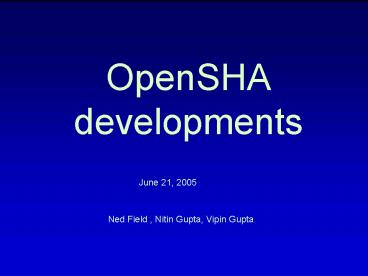OpenSHA developments - PowerPoint PPT Presentation
1 / 20
Title:
OpenSHA developments
Description:
Intensity-Measure ... Intensity-Measure Types. List of Site-Related. Independent Parameters ... Intensity-Measure Relationships (Attenuation Relationships) ... – PowerPoint PPT presentation
Number of Views:76
Avg rating:3.0/5.0
Title: OpenSHA developments
1
OpenSHA developments
June 21, 2005
Ned Field , Nitin Gupta, Vipin Gupta
2
Status of Seismic Hazard Analysis (SHA)
- SHA needs more physics
- Lack of consensus means well have multiple
options - All viable models need to be considered for
proper SHA - SHA needs a computational infrastructure capable
of handling a potentially great number of
arbitrarily complex models (a Community Modeling
Environment)
3
SHA has two model components
4
OpenSHA
A framework where any arbitrarily complex (e.g.,
physics based) SHA component can plug in for
end-to-end SHA calculations.
- open source
- object oriented
- platform ind.
- web/GUI enabled
- distributed
- Java (or wrapped code)
- validated
5
OpenSHA
SHA Models Implemented
Intensity-Measure Relationships (Attenuation
Relationships) Boore et al. (1997) Abrahamson
Silva (1997) Campbell (1997) Sadigh et al.
(1997) Field (2000) Abrahamson (2000) Campbell
Bazorgnia (2003) ShakeMap (2003) SEA (Spudich et
al., 1999) USGS Combined (2004) Wells
Coppersmith (1994)
Earthquake Rupture Forecasts PEER Area PEER
Non-Planar Fault PEER Multi-Source PEER Logic
Tree Poisson Fault ERF Fault Rupture ERF USGS/CGS
(1996) STEP So. Cal. (2003) STEP Alaska Pipeline
(2003) WGCEP (2002) USGS/CGS (2002)
6
OpenSHA
Applications Available
1) Hazard Curve Calculator
2) Scenario ShakeMap Calculator
3) Hazard Map Data Calculator
4) Hazard Map Plotter
7
OpenSHA
Applications Available
1) Hazard Curve Calculator
e.g., WGCEP-2002 ERF (Field et al. 2005,
SRL) Distributed Object Technologies (Maechling
et al., 2005, SRL)
8
OpenSHA
Applications Available
2) Scenario ShakeMap Calculator
9
OpenSHA
Applications Available
3) Hazard Map Data Calculator
4) Hazard Map Plotter
10
Advanced IT- Technologies used
- Java Distributed Computing Tech. (RMI ,
Servlets) - Web-Services
- Grid Computing using Condor at USC
- Digital Library (SRB)
- Wrapping of Legacy Codes (E.g. WGCEP-2002)
11
OpenSHA Publications
Field, E.H., T.H. Jordan, and C.A. Cornell
(2003). OpenSHA A Developing Community-Modeling
Environment for Seismic Hazard Analysis, Seism.
Res. Lett. 74, 406-419. Field, E.H., H.A
Seligson, N. Gupta, V. Gupta, T.H. Jordan, and
K.W. Campbell (2005). Loss Estimates for a Puente
Hills Blind-Thrust Earthquake in Los Angeles,
California, Earthquake Spectra, 21,
329-338. Field, E.H., N. Gupta, V. Gupta, M.
Blanpied, P. Maechling, and T.H. Jordan (2005).
Hazard Calculations for the WGCEP-2002 Earthquake
Forecast Using Distributed Object Technologies,
Seism. Res. Lett., 76, 161-167. Maechling, P.,
V. Gupta, N. Gupta, E.H. Field, D. Okaya and T.H.
Jordan. (2005) Seismic Hazard Analysis Using
Distributed Computing in the SCEC Community
Modeling Environment, Seism. Res. Lett., 76,
177-181. Field, E.H., V. Gupta, N. Gupta, P.
Maechling, and T.H. Jordan (2005). Hazard Map
Calculations Using OpenSHA and GRID Computing,
Seism. Res. Lett., Submitted undergoing
revision. Maechling, P., V. Gupta, N. Gupta,
E.H. Field, D. Okaya and T.H. Jordan. (2005).
Grid Computing in the SCEC Community Modeling
Environment , Seism. Res. Lett., Submitted
undergoing revision.
12
OpenSHA Collaborations
- Code validation via PEER PSHA Working Group
- HAZUS study of gt100 WG02, Bay-Area scenarios
(Reasenberg, USGS) - Fault-offset probability computed at the Alaska
Oil Pipeline (for Alyeska) - Hazard calculations for the USGS Short-Term
Earthquake Probability (STEP) maps (USGS,
Pasadena) - Historical MMI tests (Mark Stirling)
- NSHMP application for engineers (E.V.
Leyendecker, USGS Golden) - NSHMP loss estimation methodology (N. Luco, USGS
Golden) - Prototype application for PAGER (P. Earle, USGS
Golden)
13
Near-Future Work
- Implement NGA models (PEER)
- PEER PSHA test-cases result submission/comparison
- Implementation Evaluation of RELM models
(Stirling) - Implementation of RELM tests (Schorlemmer)
- New site effect modules (e.g., Rathje, Stewart)
- Implement Vector-valued PSHA (Thio)
- Educational Tools within our framework (e.g.,
Stewart) - Waveform-based IMRs (e.g., 1D from Thio, Zeng and
3D from Pathway 2 of ITR) - Implementation of the WGCEP UCERF (heavy
interoperability requirements) - Full PSHA interface to HAZUS
14
OpenSHA
Pathway 1
15
Intensity-Measure Relationship (IMR)
IMT, IML(s)
Site(s)
Rupture
Intensity-Measure Relationship List of Supported
IMTs List of Site-Related Ind. Params
16
Waveform based IMR
E.g. CyberSHAke
Site
Region
Eqk Rupture
STF generator
Greens Functions generator
Ruptures with STF(1 - n)
Greens Functions for each location on rupture
Seismogram from Greens Function Calculator
Seismograms (1 - n)
IMT, IML(s)
Probabilities
Empirical Dist
17
Waveform based IMR
E.g. CyberSHAke
Site
Region
Eqk Rupture
STF generator
Greens Functions generator
Ruptures with STF(1 - n)
Greens Functions for each location on rupture
Seismogram from Greens Function Calculator
Seismograms (1 - n)
IMT, IML(s)
Probabilities
Empirical Dist
18
ScenarioShakeMap Application
Demo
19
Improving SHA
On-demand, waveform-based SHA TerraShake (e.g.,
losses from scenarios) CyberShake (e.g., for
building design) using arbitrary
EqRuptureWithSlipTimeFunctions AWM or
GreensFunctionGen. (1D-3D, high freq.,
nonlin.) Earthquake Rupture Forecasts (model
components) RELM/CSEP models and formal tests
thereof WGCEP Uniform California ERF (for CEA)
20
UCERF Model Components
Fault Model(s)
Historical Qk Catalog
(A)
Black Box
Fault Section Database
Instrumental Qk Catalog
Deformation Model(s)
(B)
Dyn. Stress-Change Calc.
Black Box
(C)
GPS Database
Earthquake Rate Model(s)
Black Box
Paleo Site Database
(D)
Static Stress-Change Calc.
Earthquake Prob Model(s)































